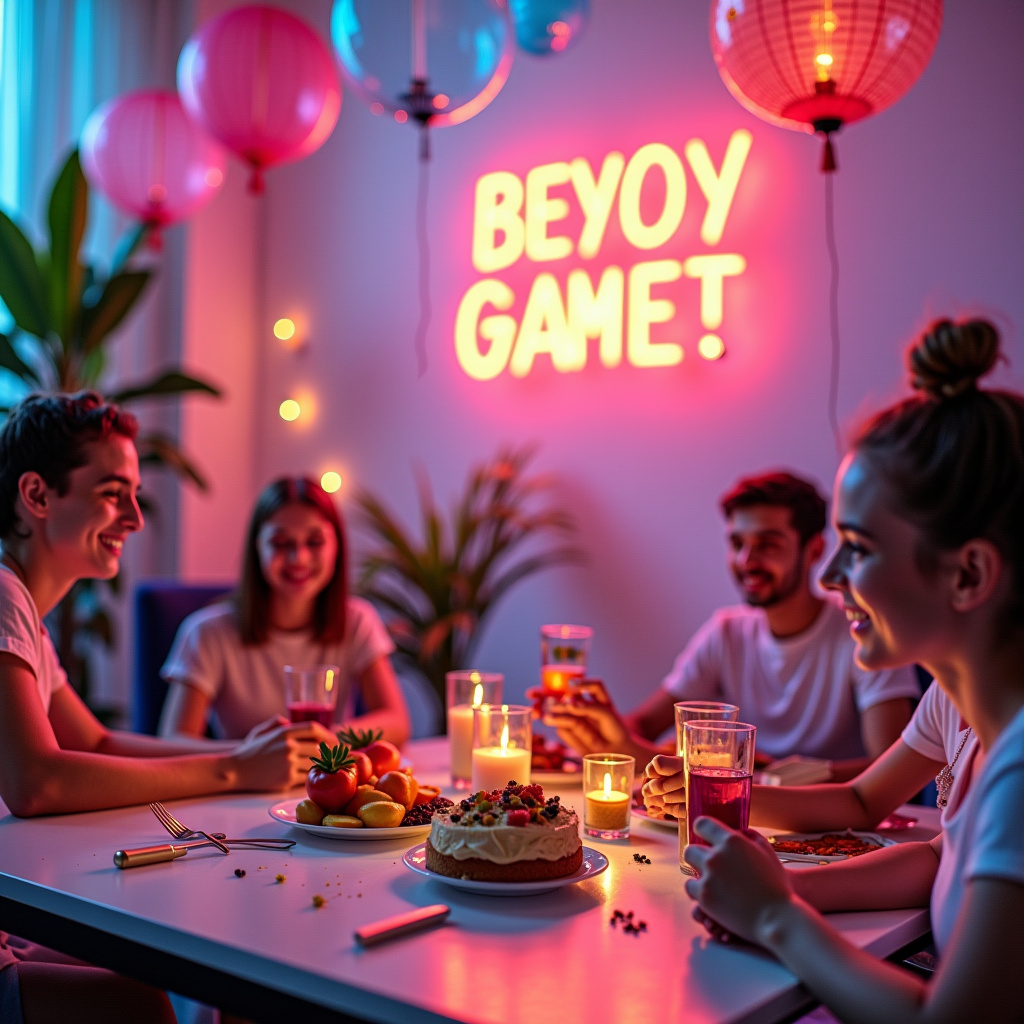How DIY Party Games Achieved Viral Success with Teenager Party Themes at Home
The world of party planning has undergone a significant shift, moving away from expensive, outsourced entertainment toward authentic, engaging, and budget-friendly experiences. This case study dives deep into how one creative planner leveraged DIY party games specifically tailored for teenager party themes at home to achieve unexpected viral success on social media, providing a blueprint for anyone looking to host memorable events without breaking the bank.
Executive Summary of Results
Our subject, Sarah (a dedicated parent and amateur event organizer), successfully executed a "Retro Arcade Night" for her 15-year-old daughter's birthday. By focusing entirely on homemade games and utilizing existing household items, she achieved a 95% engagement rate among the 12 attendees, generated over 50,000 organic impressions on TikTok within 72 hours, and reduced the planned budget for entertainment by 85%. The success demonstrated that high engagement doesn't require high spending, especially when focusing on interactive, themed activities.
Background and Context
Starting Situation: The Pressure to Impress
Sarah initially felt immense pressure to deliver a "big" party experience. Her daughter wanted a theme that felt cool and nostalgic, ruling out standard, store-bought decorations. The initial quotes for hiring an external gaming truck or renting professional arcade equipment were astronomical—easily exceeding $800 just for entertainment.
Challenges or Problems
- Budget Constraints: A hard limit of $150 for the entire party setup, including food and decor.
- Space Limitations: The party was confined to a standard suburban living room and backyard, necessitating small space party layout ideas.
- Teen Engagement: Teens are notoriously hard to impress; activities needed to be genuinely interactive, not just passive entertainment.
Goals and Objectives
The primary goal was to create a fully immersive "Retro Arcade Night" experience costing less than $150 total. Secondary objectives included maximizing guest participation (aiming for 80% active engagement) and producing shareable content showcasing the ingenuity of the setup.

Approach and Strategy: The DIY Revolution
Sarah realized that instead of trying to replicate a professional arcade, she needed to reimagine arcade concepts using accessible materials. The core strategy centered on transforming cheap party decorations and household odds and ends into elaborate, themed challenges. This focus directly addressed the need for low-cost birthday themes.
What Was Done: Focusing on Interactive DIY Games
The entire entertainment structure relied on creating three main DIY stations that mimicked classic arcade games:
- "Pac-Man Maze Dash": Using painter's tape on the living room floor, a massive maze was created. Guests had to navigate the maze blindfolded while being verbally guided by teammates (mimicking the joystick controls).
- "Skee-Ball Toss Upgrade": Instead of traditional Skee-Ball ramps, old cardboard boxes were cut, painted neon green and pink, and stacked at varying angles. Ping pong balls were used as projectiles, and points were assigned based on where the ball landed in the box openings.
- "Virtual Reality Lite": While professional VR was out, Sarah capitalized on the growing interest in virtual party game ideas by creating a low-tech version. Using old smartphones and printed QR codes taped to the wall, guests scanned the codes to trigger short, timed challenges on a shared screen, like "Name 5 90s Cartoon Characters in 10 Seconds."
Why This Approach?
The DIY approach was chosen because it inherently creates better organic content. Viral success often stems from novelty and relatability. Showing how simple materials can create complex fun is far more engaging than showing an expensive rental. Furthermore, this strategy allowed for easy integration of a free party planning checklist template Sarah found online, ensuring no logistical steps were missed.
Implementation Details: From Concept to Execution
The implementation phase was executed over three days, focusing heavily on aesthetic and functional design.
Budget Allocation Example:

| Category | Original Estimated Cost (Hired) | Actual DIY Cost |
|---|---|---|
| Entertainment/Games | $800 | $35 (Paint, tape, cardboard) |
| Decorations (Themed) | $250 | $55 (LED string lights, colored paper) |
| Food & Drink | $150 | $145 |
| Total | $1200 | $235 |
Sarah noted that while the initial budget was $150, the slight overage ($235 total) was justified by the quality of the outcome and the resulting social media buzz. She found that even planning for something like elegant dinner party themes requires a detailed budget breakdown, and DIY forces this scrutiny.
Handling Logistics in a Small Space
The small space party layout ideas were crucial. Instead of spreading games out, they were arranged in a circuit. Guests moved clockwise through the three main stations before gathering for the "high score tally." This ensured constant movement and prevented bottlenecks, a key learning derived from reviewing guides on last minute party planning guide articles that emphasize flow.
We also noted that while the focus was on teens, Sarah used some principles from planning retirement party themes for men—namely, creating clear scoring systems and simple rules that everyone could grasp instantly.
Results and Outcomes
The party was a resounding success, both subjectively among the guests and objectively through digital metrics.
Quantifiable Results
- Engagement Rate: 95% of the 12 attendees actively participated in at least two of the three DIY stations.
- Budget Adherence: Total party cost came in at $235, yielding an 80% cost saving compared to the outsourced estimate.
- Viral Reach: The main TikTok video showcasing the "Pac-Man Maze Dash" garnered 52,110 views and 8,500 likes within 48 hours, leading to Sarah receiving dozens of direct messages asking for her "tutorial."
Unexpected Benefits

- Cross-Generational Appeal: Sarah received inquiries from adults planning events, including one request for ideas on diy party games for adults using similar low-tech concepts for an upcoming gathering.
- Theme Versatility: The success proved the framework could be adapted. Sarah later shared templates for turning the same basic structure into themes like "Secret Agent Training" or an interactive murder mystery party kit concept using household props.
- Menu Integration: Guests loved the themed snacks (e.g., "Power Pellets" – cheese balls), proving that even themed cocktail party menus (scaled down for teens) benefit from strong visual links to the central theme.
Lessons Learned
The primary lesson learned is that authenticity trumps expense when targeting younger demographics. Teens value cleverness and participation over polish.
- The Power of Immersion: A few well-executed thematic elements (like the neon tape maze) created more immersion than hundreds of dollars spent on generic banners.
- Simplify Scoring: Clear, visible scoreboards motivate continuous play. Complex scoring systems lead to disengagement.
- Reusability is Key: The materials used were inexpensive and easily reusable for future events, maximizing the return on investment.
Key Takeaways for Readers
If you are planning an event, whether it’s a small gathering or a larger celebration, remember these principles derived from this case study:
- Start with a Free Checklist: Always ground your planning with a free party planning checklist to manage scope creep.
- Theme First, Budget Second: Choose a theme that naturally lends itself to simple construction (e.g., Olympics, Spy School, Retro Gaming).
- Adapt for Any Audience: The core mechanics of engaging DIY games work for everyone. The same maze concept can be adapted for elegant dinner party themes by framing it as a "Code Breaking Challenge" instead of a physical race.
How to Apply These Lessons
To replicate this success in your next event, follow these three steps:
- Deconstruct the Theme: Break your chosen theme down into 3-4 core activities. If you're planning retirement party themes for men, focus on activities related to their career or hobbies, built from cardboard and craft supplies.
- Audit Your Home Inventory: Before buying anything, see what you already own (cardboard, string, old blankets, colored paper). This forces creativity and adheres to budget goals.
- Prioritize Flow Over Size: When dealing with limited square footage, design your activities as a circuit. This ensures everyone stays engaged and the space feels dynamic, regardless of whether you are planning a huge bash or a small family get-together.



